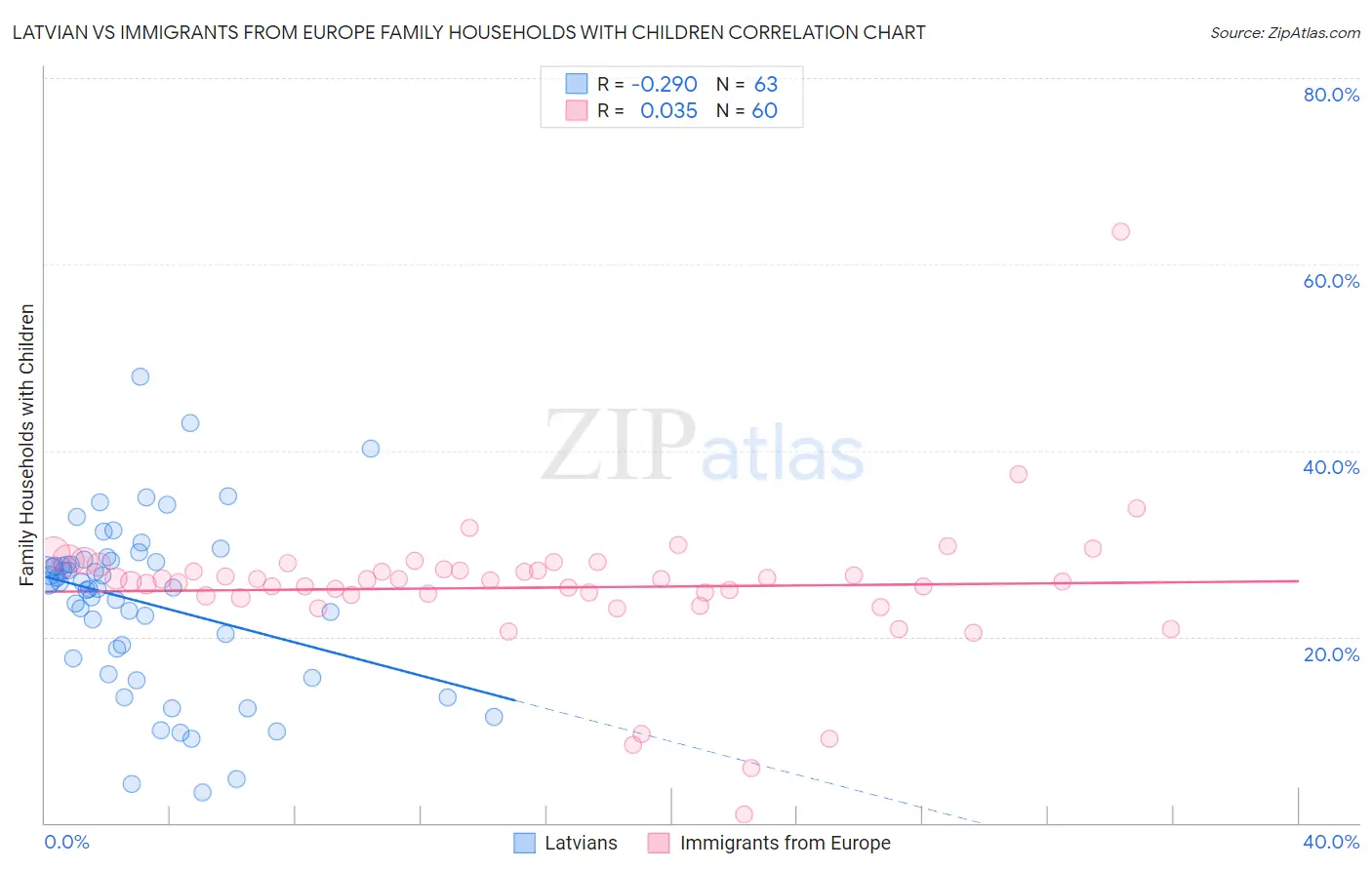Latvian vs Immigrants from Europe Family Households with Children
COMPARE
Latvian
Immigrants from Europe
Family Households with Children
Family Households with Children Comparison
Latvians
Immigrants from Europe
26.4%
FAMILY HOUSEHOLDS WITH CHILDREN
0.1/ 100
METRIC RATING
294th/ 347
METRIC RANK
26.6%
FAMILY HOUSEHOLDS WITH CHILDREN
0.4/ 100
METRIC RATING
278th/ 347
METRIC RANK
Latvian vs Immigrants from Europe Family Households with Children Correlation Chart
The statistical analysis conducted on geographies consisting of 220,571,323 people shows a weak negative correlation between the proportion of Latvians and percentage of family households with children in the United States with a correlation coefficient (R) of -0.290 and weighted average of 26.4%. Similarly, the statistical analysis conducted on geographies consisting of 546,548,377 people shows no correlation between the proportion of Immigrants from Europe and percentage of family households with children in the United States with a correlation coefficient (R) of 0.035 and weighted average of 26.6%, a difference of 0.62%.

Family Households with Children Correlation Summary
| Measurement | Latvian | Immigrants from Europe |
| Minimum | 3.3% | 0.93% |
| Maximum | 48.0% | 63.5% |
| Range | 44.7% | 62.6% |
| Mean | 23.7% | 25.3% |
| Median | 25.8% | 26.1% |
| Interquartile 25% (IQ1) | 17.7% | 24.5% |
| Interquartile 75% (IQ3) | 28.1% | 27.5% |
| Interquartile Range (IQR) | 10.4% | 3.0% |
| Standard Deviation (Sample) | 9.1% | 8.0% |
| Standard Deviation (Population) | 9.0% | 7.9% |
Demographics Similar to Latvians and Immigrants from Europe by Family Households with Children
In terms of family households with children, the demographic groups most similar to Latvians are Black/African American (26.5%, a difference of 0.060%), Macedonian (26.4%, a difference of 0.080%), Croatian (26.4%, a difference of 0.10%), Polish (26.5%, a difference of 0.11%), and Albanian (26.5%, a difference of 0.12%). Similarly, the demographic groups most similar to Immigrants from Europe are Finnish (26.6%, a difference of 0.020%), Senegalese (26.6%, a difference of 0.050%), Celtic (26.6%, a difference of 0.060%), Immigrants from Spain (26.6%, a difference of 0.14%), and Lithuanian (26.6%, a difference of 0.14%).
| Demographics | Rating | Rank | Family Households with Children |
| Immigrants | Spain | 0.5 /100 | #276 | Tragic 26.6% |
| Celtics | 0.4 /100 | #277 | Tragic 26.6% |
| Immigrants | Europe | 0.4 /100 | #278 | Tragic 26.6% |
| Finns | 0.4 /100 | #279 | Tragic 26.6% |
| Senegalese | 0.4 /100 | #280 | Tragic 26.6% |
| Lithuanians | 0.3 /100 | #281 | Tragic 26.6% |
| French American Indians | 0.3 /100 | #282 | Tragic 26.6% |
| Immigrants | North America | 0.3 /100 | #283 | Tragic 26.6% |
| Immigrants | Canada | 0.3 /100 | #284 | Tragic 26.5% |
| Cambodians | 0.2 /100 | #285 | Tragic 26.5% |
| Immigrants | Senegal | 0.2 /100 | #286 | Tragic 26.5% |
| Shoshone | 0.2 /100 | #287 | Tragic 26.5% |
| Russians | 0.2 /100 | #288 | Tragic 26.5% |
| Immigrants | Sweden | 0.2 /100 | #289 | Tragic 26.5% |
| Albanians | 0.2 /100 | #290 | Tragic 26.5% |
| Bahamians | 0.2 /100 | #291 | Tragic 26.5% |
| Poles | 0.2 /100 | #292 | Tragic 26.5% |
| Blacks/African Americans | 0.1 /100 | #293 | Tragic 26.5% |
| Latvians | 0.1 /100 | #294 | Tragic 26.4% |
| Macedonians | 0.1 /100 | #295 | Tragic 26.4% |
| Croatians | 0.1 /100 | #296 | Tragic 26.4% |